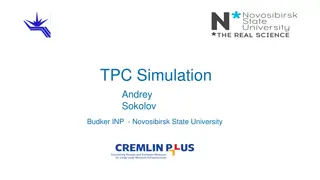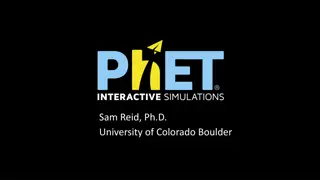Understanding Nucleation Sites in MatCalc Simulations
Nucleation sites of precipitates in MatCalc simulations are crucial for understanding the nucleation rate, available sites, interfacial energy models, and more. This analysis delves into the consequences and special cases of nucleation, including factors such as dislocation density, grain boundaries, and polygon concepts.
Download Presentation

Please find below an Image/Link to download the presentation.
The content on the website is provided AS IS for your information and personal use only. It may not be sold, licensed, or shared on other websites without obtaining consent from the author. Download presentation by click this link. If you encounter any issues during the download, it is possible that the publisher has removed the file from their server.
E N D
Presentation Transcript
Nucleation sites of preciptates in MatCalc simulations (MatCalc 5.61.0017) P. Warczok
What is it all about? Consequences Number of available nucleation sites Interfacial energy model Precipitate growth & coarsening nucleation on grain boundaries Special cases: Nucleation on/within precipitates
Number of available nucleation sites Nucleation rate ?~?? ? Nucleation rate ?? Number of nucleation sites on ? position Available nucleation sites bulk ?? Avogadro number ?? Molar volume Nbulk= NA/Vm ? Dislocation density Available nucleation sites dislocations 1/3 Ndisl= ? NA/Vm
Number of available nucleation sites Grain&subgrain boundaries tetra(kai)decahedron concept Strictly: Truncated octahedron a ??? = 8 2?3 ??? = 6 1 + 2 3 ?2 ??? = 36? ??? Volume of the polygon ??? Total surface of the polygon ??? Total edge length of the polygon http://mathworld.wolfram.com/TruncatedOctahedron.html
Number of available nucleation sites Grain&subgrain boundaries tetra(kai)decahedron concept Strictly: Truncated octahedron ??? = 8 2?3 ? =???/??? ??? = 6 1 + 2 3 ?2 10 ??? = 36? ??? Grain diameter ??? Volume of the polygon ???? Subgrain diameter ??? Total surface of the polygon ??? Total edge length of the polygon
Number of available nucleation sites Grain&subgrain boundaries tetra(kai)decahedron concept Strictly: Truncated octahedron ? =???/??? ??? Grain diameter ??? = 8 2?3+ 6?2? ???? Subgrain diameter 10 ??? Elongation factor for grains ??? = 6 1 + 2 3 ?2+ 2? 2? + ? ??? Elongation factor for subgrains ??? = 36? + 8? 2 2 ???/??? 5 ???/??? 5 ??? Volume of the polygon 2 ? = ???/??? 2 ??? Total surface of the polygon ??? Total edge length of the polygon
Number of available nucleation sites Grain&subgrain boundaries tetra(kai)decahedron concept Strictly: Truncated octahedron ? =???/??? ??? Grain diameter ???? Subgrain diameter 10 ??? Elongation factor for grains ??? Elongation factor for subgrains 2 2 ???/??? 5 ???/??? 5 2 ? = ???/??? 2
Number of available nucleation sites Available nucleation sites grain&subgrain boundaries 2/3 ??? 2??? ?? ?? ???/???= Available nucleation sites grain&subgrain boundary edges 1/3 ??? 3??? ?? ?? ????/????= Available nucleation sites grain&subgrain boundary corners 6 ????/????= ???
Number of available nucleation sites Nucleation site efficiency scales linearly the number of available nucleation sites
Interfacial energy model Bulk & dislocations standard interfacial energy evaluation Grain & subgrains (surface, edges, corners) Clemm-Fisher model ??? 2??? ???? = ?,?,? = f ???? ???? ???? 336??2 ??? Grain boundary energy ???= ??? Precipitate/matrix interfacial energy Clemm P.J., Fisher J.C., Acta Metall. 3 (1955) 70-73
Interfacial energy model Bulk & dislocations standard interfacial energy evaluation Grain & subgrains (surface, edges, corners) Clemm-Fisher model ??? Grain boundary energy ??? Precipitate/matrix interfacial energy
Interfacial energy model Grain & subgrains surfaces ? = 1 ???2? ? = 4 1 ???? ? =2 3 2 3???? + ???2? Clemm P.J., Fisher J.C., Acta Metall. 3 (1955) 70-73
Interfacial energy model Grain & subgrains edges ? = 3? 1 ???2? ???? 3 4???2? ? 2 ? ????? ? = 12 ? = 2 2? + ???2? 3 4???2? ????? 3 ???2? 1 ???? ? = ?????? ? = ?????? 1 ???2? 3 1 ???2? 2 Clemm P.J., Fisher J.C., Acta Metall. 3 (1955) 70-73
Interfacial energy model Grain & subgrains corners 4 ?2 1 ???2? ?2 ? = 3 2? 1 ???2? ? 8 ? 3 ????? ? ? = 24 4 ?2 1 ???2? ?2 ? 3 ? + ????? 2????? 3 ???2? ? = 2 4 8 ? 2 ???? 3 ?2 ? =4 3 2 2???2? 3 ? = ?????? ? = ?????? 2???? 1 ???2? 2 3 1 ???2? ? Clemm P.J., Fisher J.C., Acta Metall. 3 (1955) 70-73
Interfacial energy model Clemm-Fisher model needs to be activated! Clemm P.J., Fisher J.C., Acta Metall. 3 (1955) 70-73
Interfacial energy model Bulk & dislocations standard interfacial energy evaluation Grain & subgrains (surface, edges, corners) Clemm-Fisher model ??? 2??? ???? = ?,?,? = f ???? ???? ???? 336??2 ??? Grain boundary energy ???= ??? Precipitate/matrix interfacial energy Clemm P.J., Fisher J.C., Acta Metall. 3 (1955) 70-73
Precipitate growth & coarsening Difference in diffusion fields
Precipitate growth & coarsening Difference in diffusion fields modification of radius evolution equations derived from thermodynamic extremum principle Kozeschnik et al., Modelling Simul. Mater. Sci. Eng. 18 (2010) 015011
Precipitate growth & coarsening Difference in diffusion fields modification of radius evolution equations derived from thermodynamic extremum principle Precipitation of AlN at austenite at grain boundaries Kozeschnik et al., Modelling Simul. Mater. Sci. Eng. 18 (2010) 015011
Precipitate growth & coarsening Difference in diffusion fields modification of radius evolution equations derived from thermodynamic extremum principle - The grain boundary diffusion field model is automatically used when NOTE: grain boundary is selected as the nucleation site - This model is relevant for the system with large grain size and small precipitate phase fractions. - In other cases, use the random diffusion field model select other nucleation sites (e.g. dislocations ) and adjust the available number of Precipitation of AlN at austenite at grain boundaries the nucleation sites using the nucleation site efficiency Kozeschnik et al., Modelling Simul. Mater. Sci. Eng. 18 (2010) 015011
Nucleation on the precipitate surface Available nucleation sites atoms on the surface of the parent phase 2/3 ?? ?? ?? - Number of precipitates in class j 2 ?????,????= 4? ???? ??- Radius of precipitates in class j ????? Parent phase is not modified by the nucleation of the new phase
Nucleation within the precipitate Available nucleation sites atoms on the surface of the parent phase (as in the previous case) Nucleation , ????> ??????? ?????,???= ???? ??????? ???? - Driving force of the new phase ?????,??? - Nucleation driving force of the new phase ??????? - Driving force of the parent phase Interfacial energy defined by user, critical radius from parent prec. Parent phase transforms gradually into the new one
Transformation of the precipitate Transformation towards rather than nucleation of the new precipitate Transformation condition: , ????> ??????? ?????,???= ???? ??????? New precipitate size taken from the parent phase Initial precipitate composition might be taken from the parent phase
Transformation of the precipitate Parent phase transforms gradually into the new one
Transformation of the precipitate Parent phase transforms gradually into the new one
Direct particle transformation For the two last cases: (nucleation within and transformation of the precipitate) Change the nucleation model to direct particle transformation !
Acknowledgments Yao Shan























